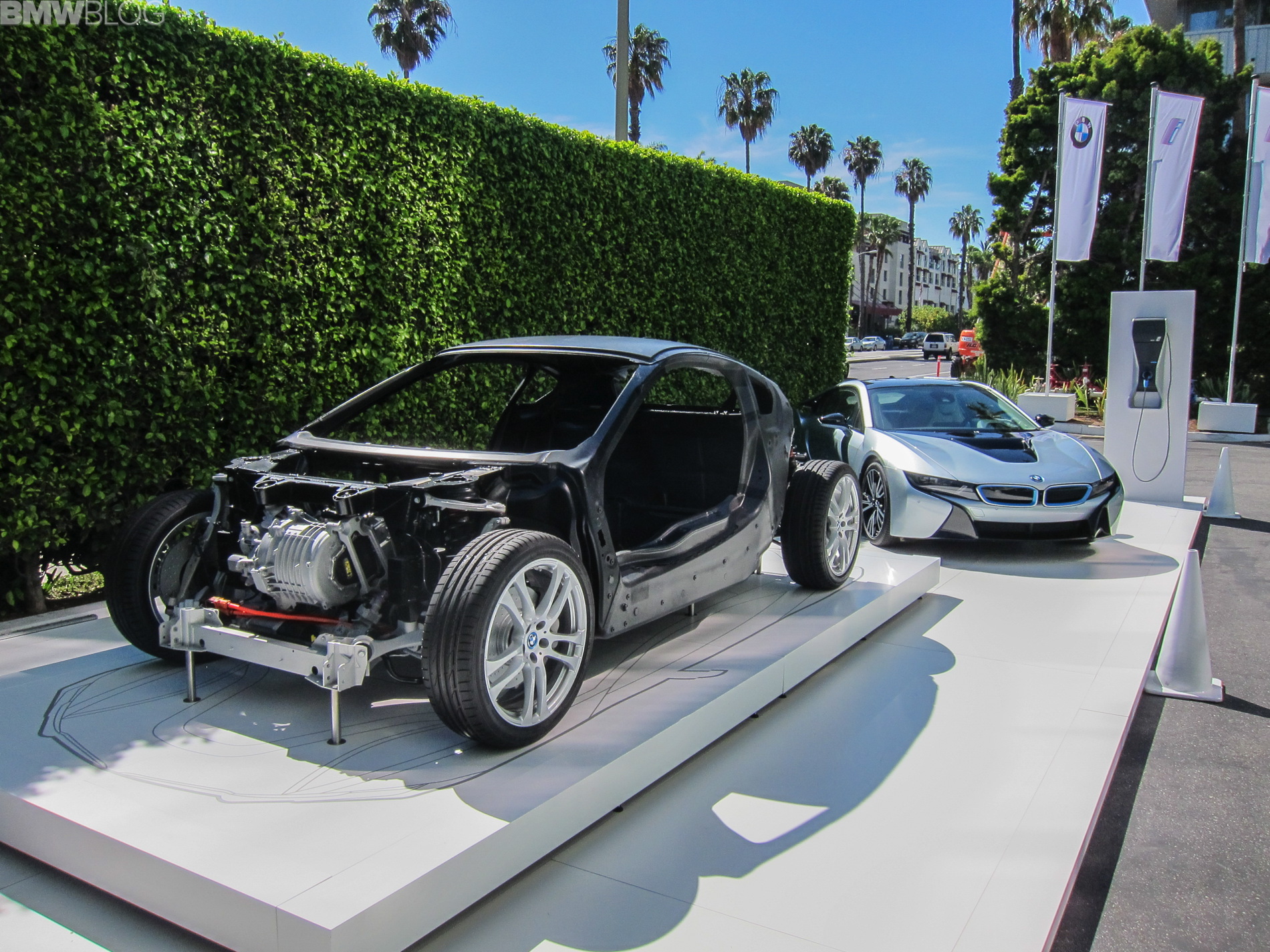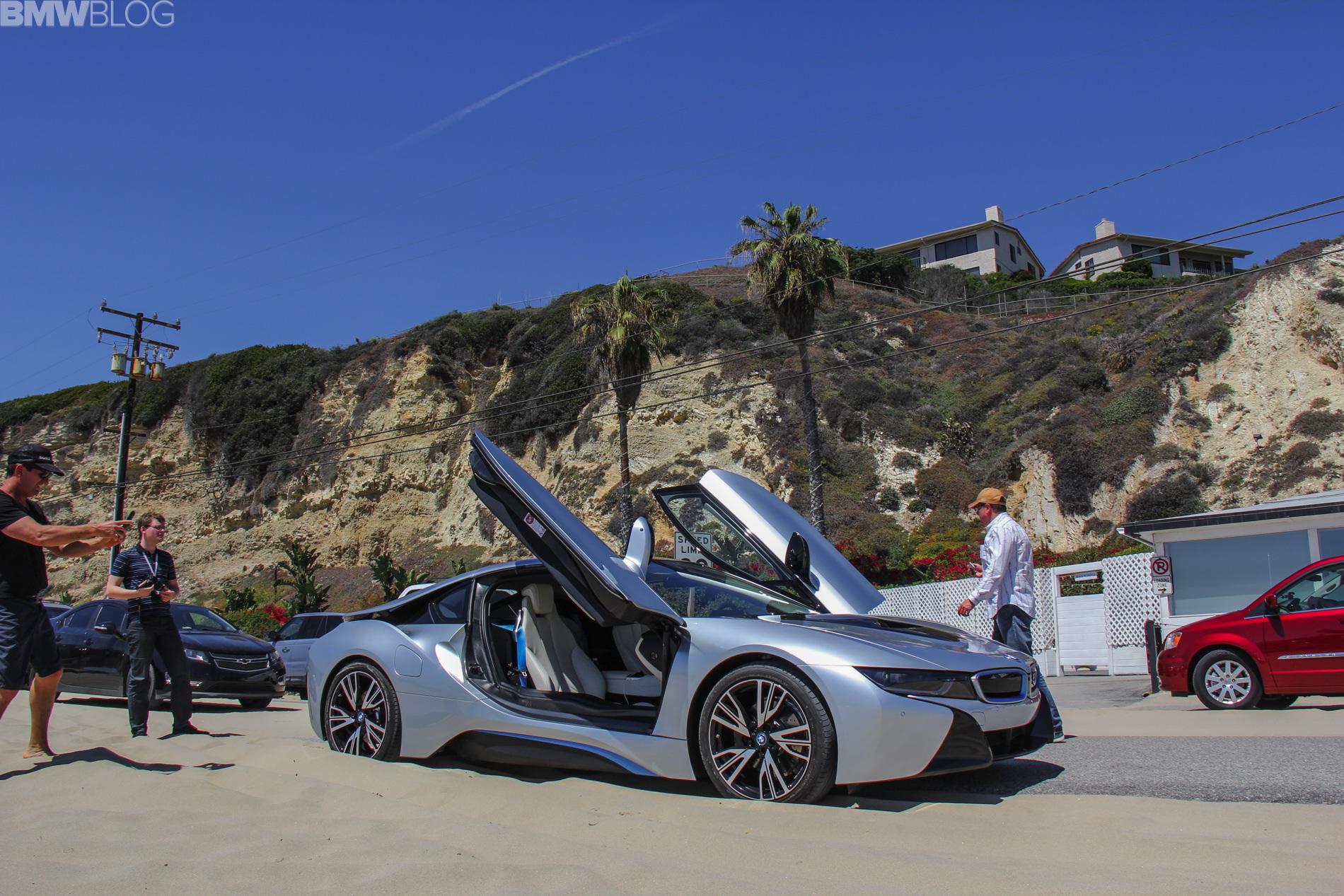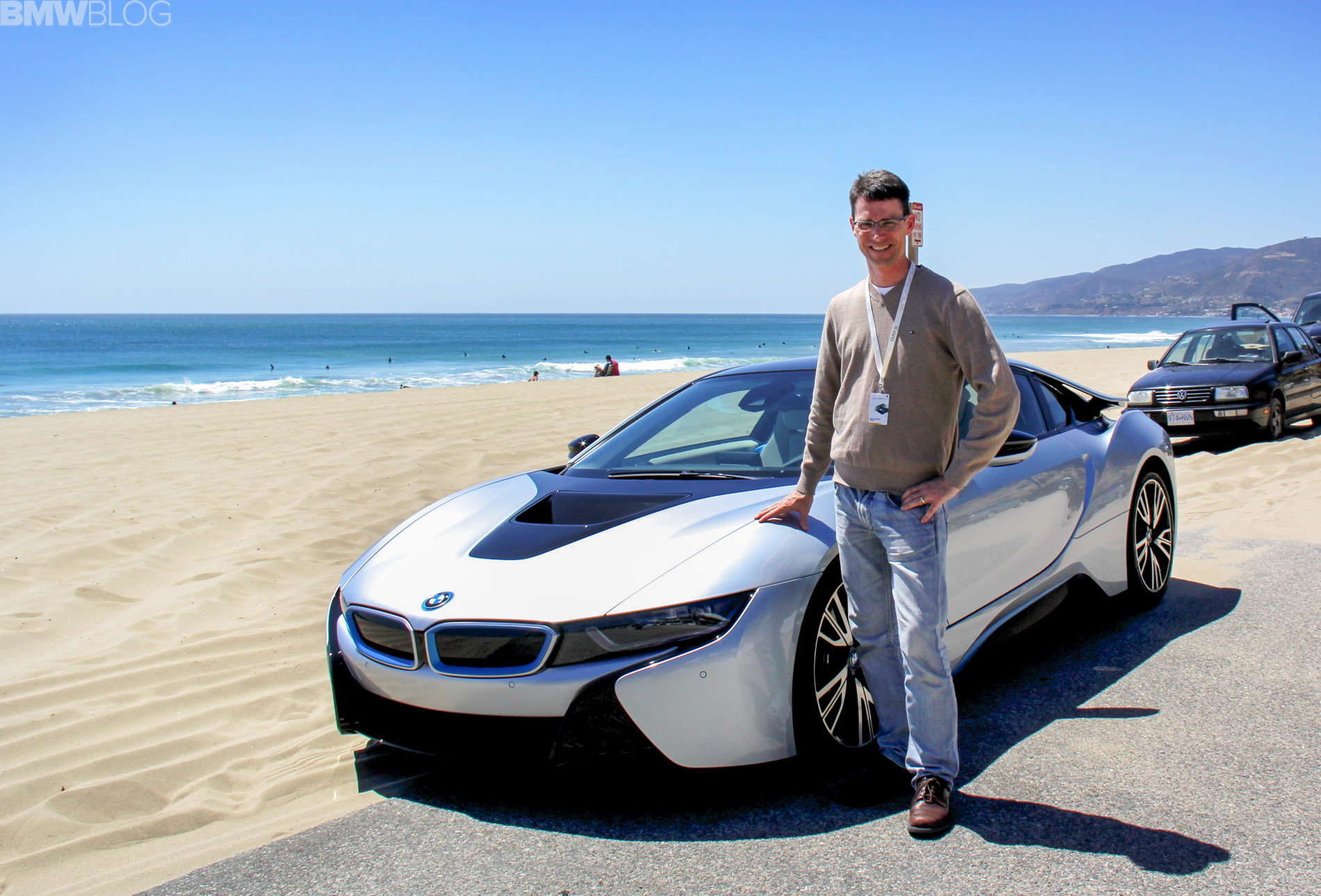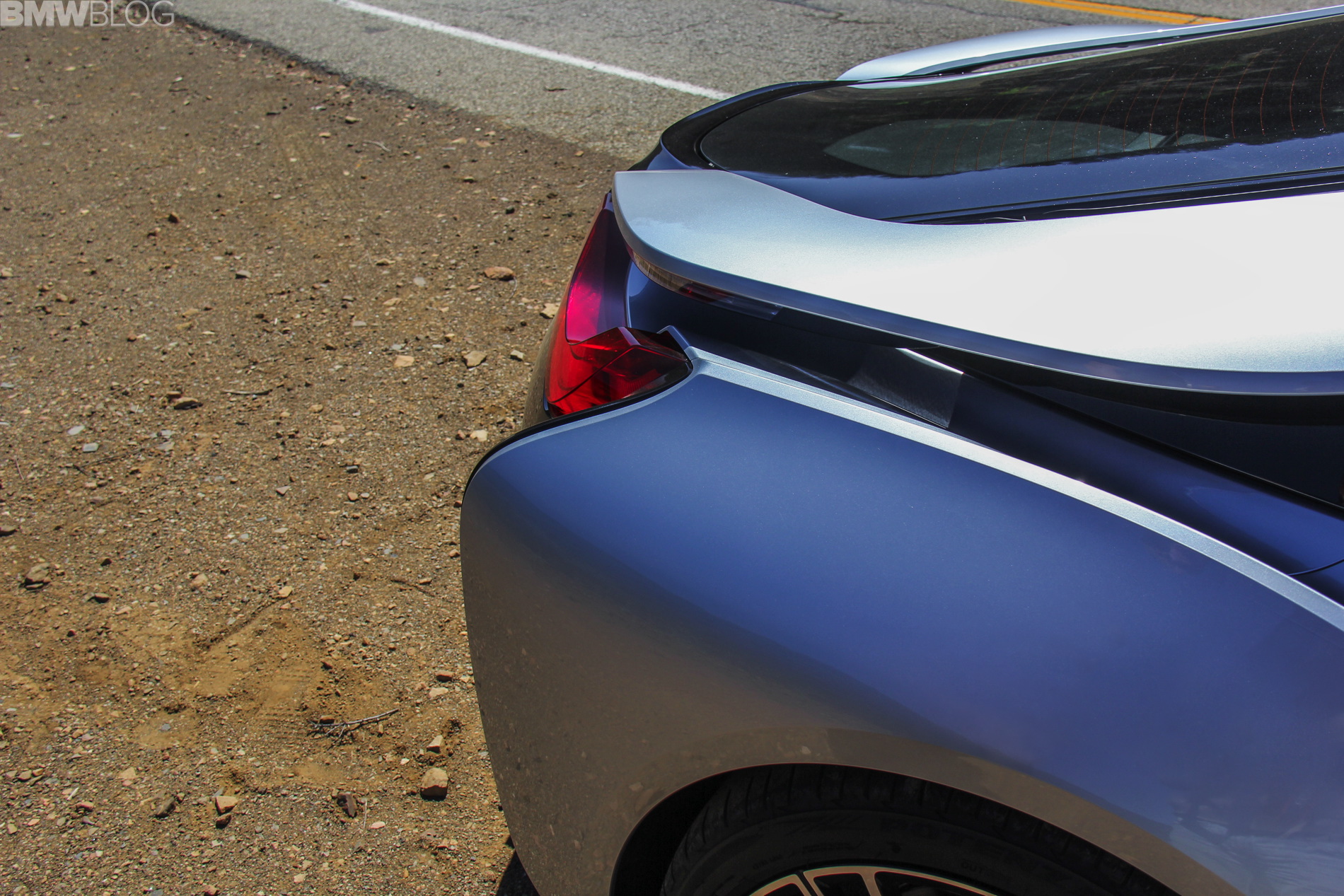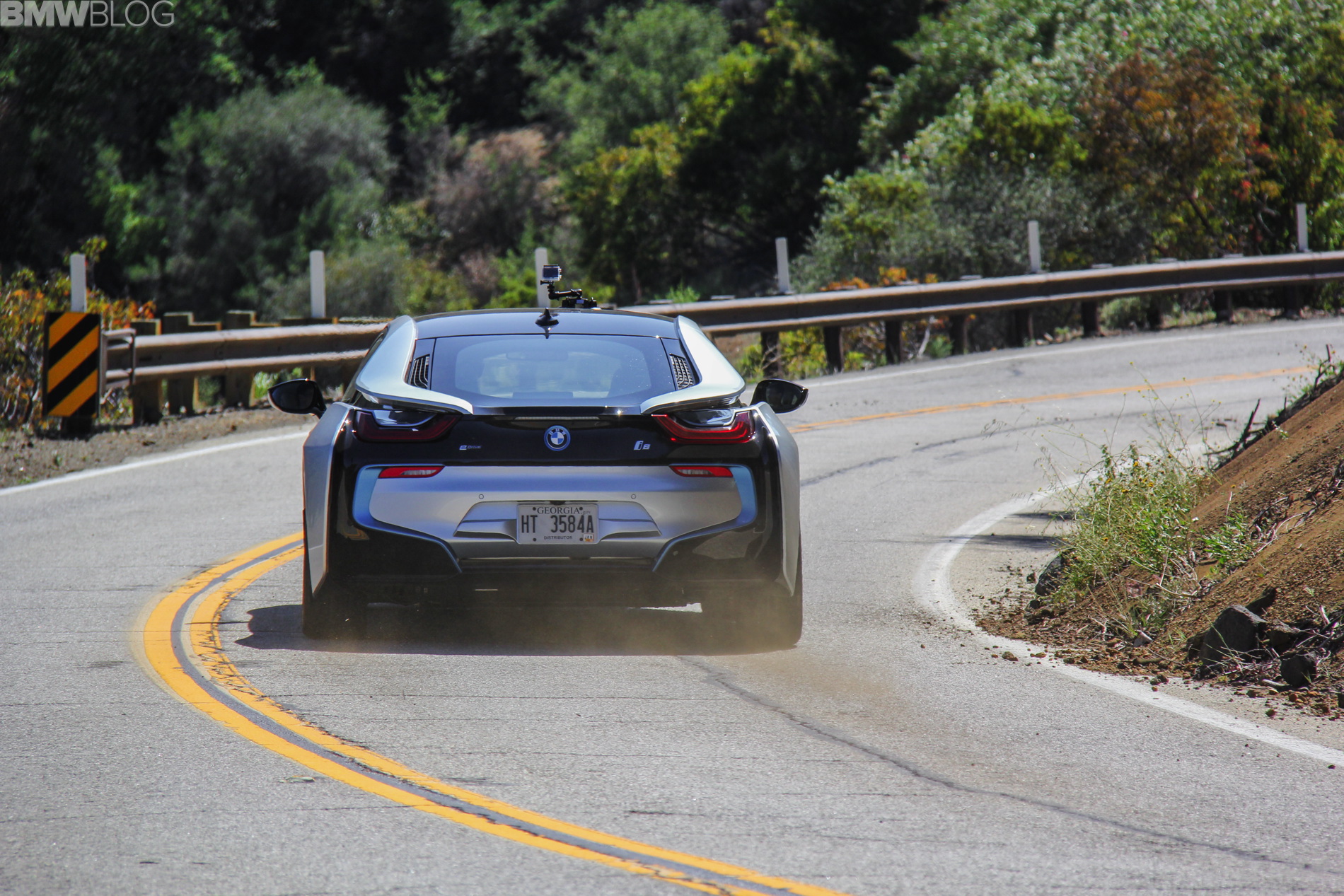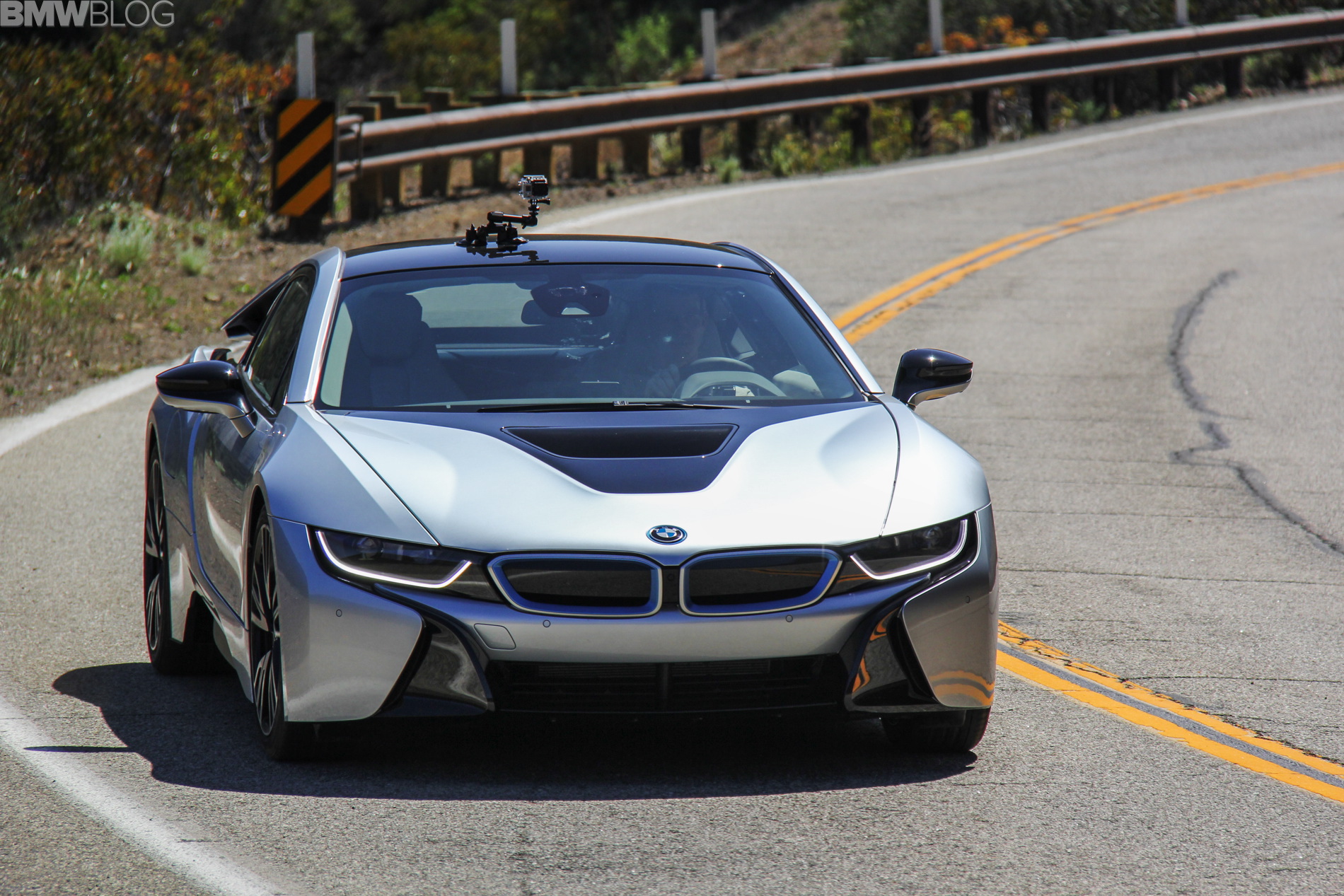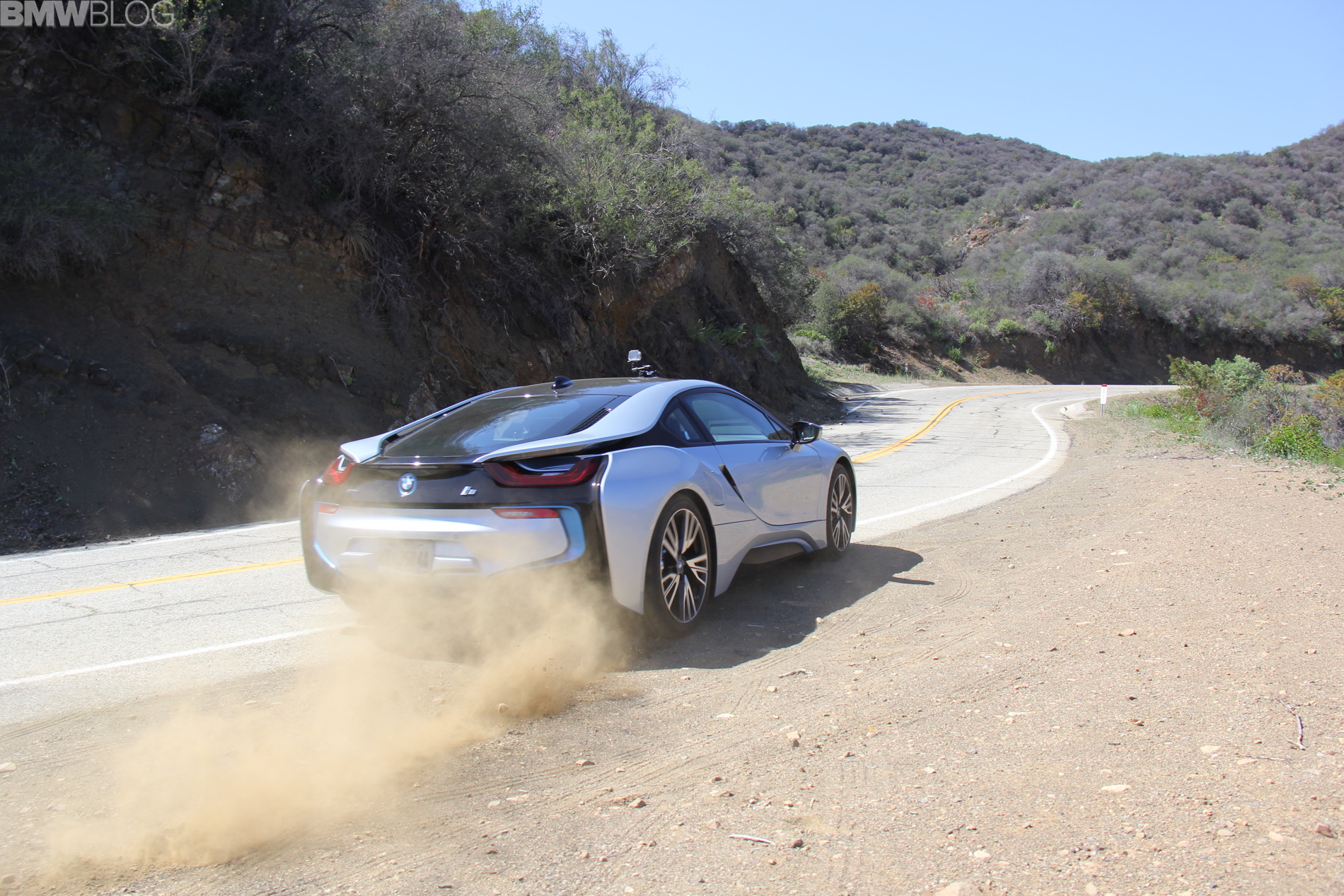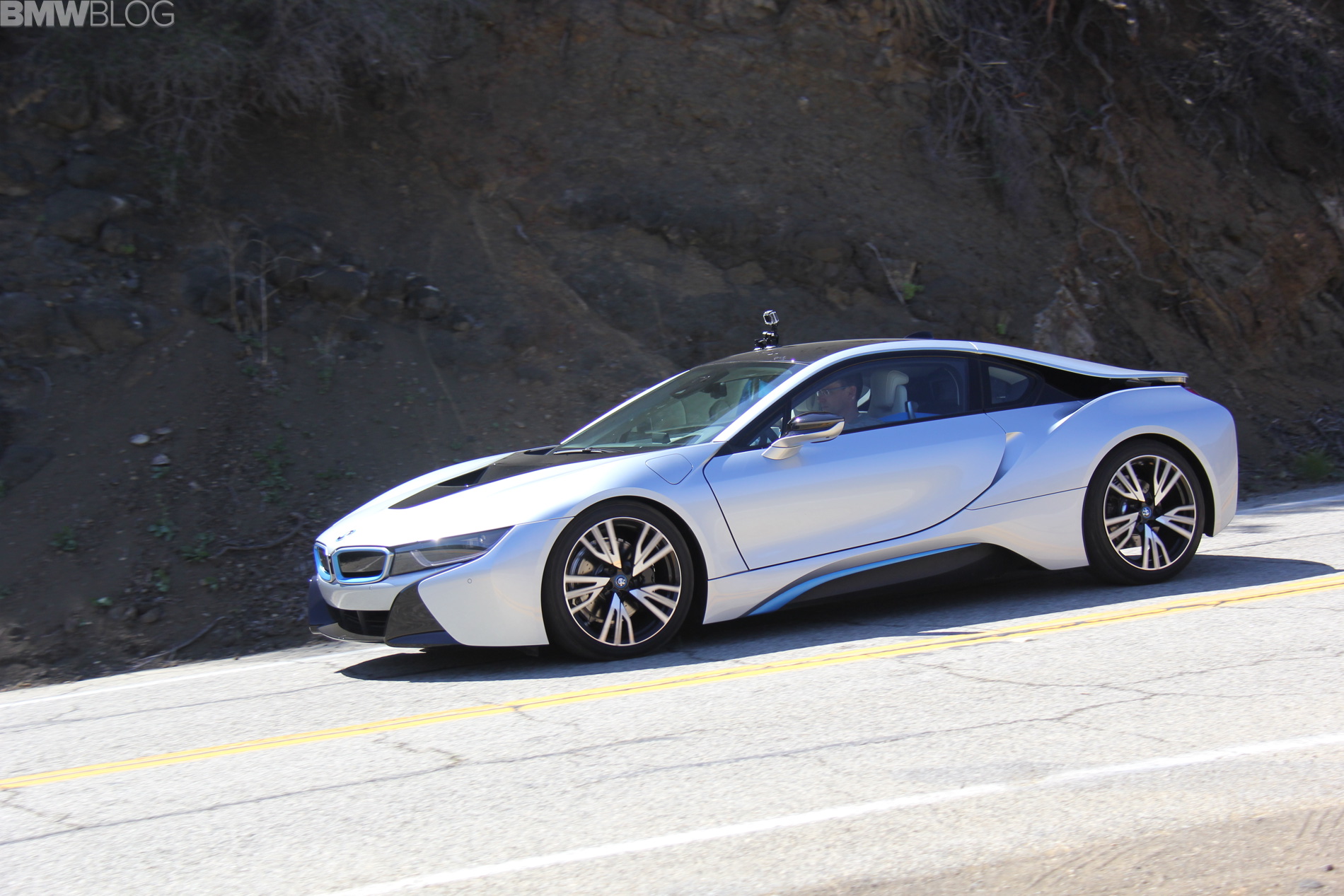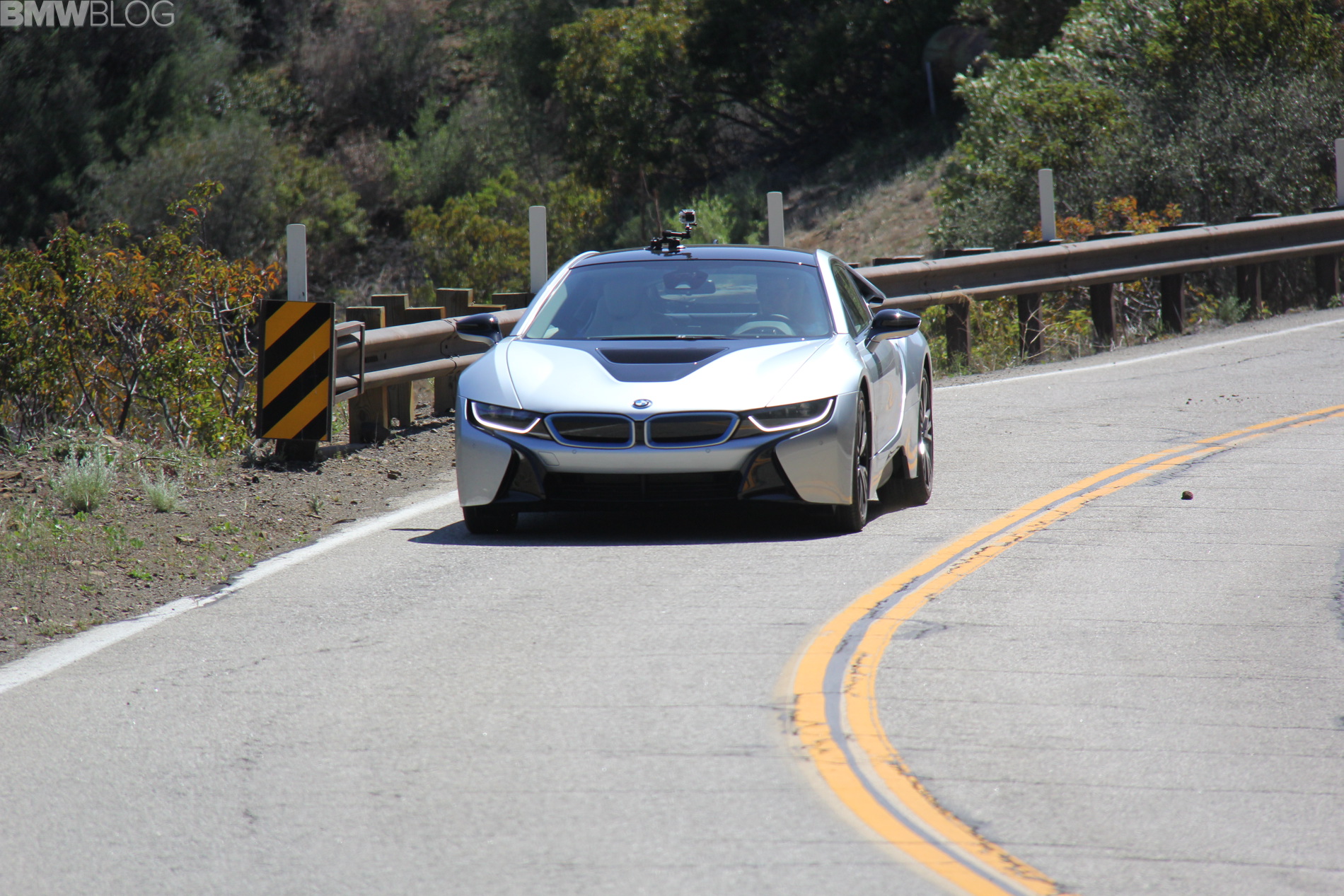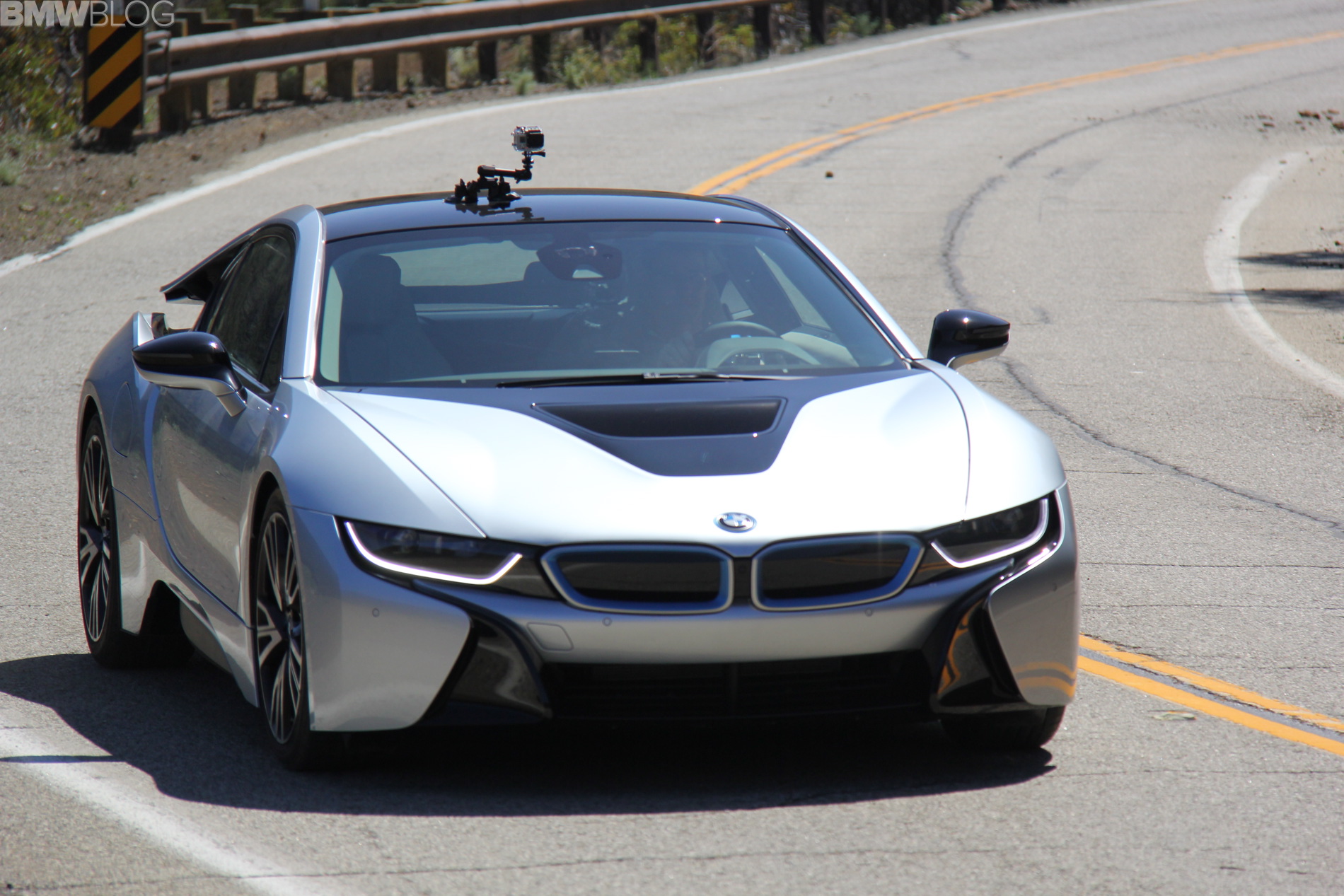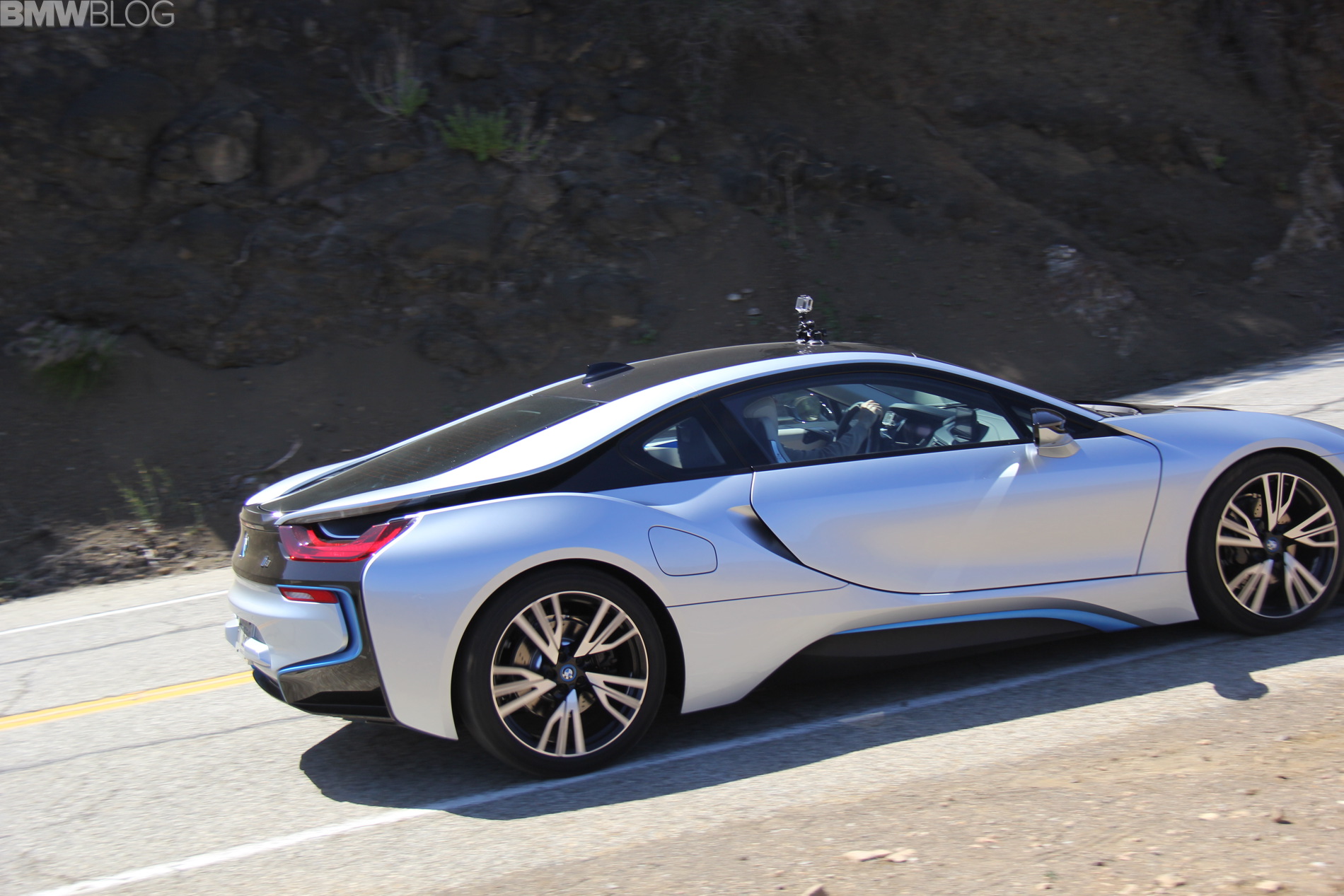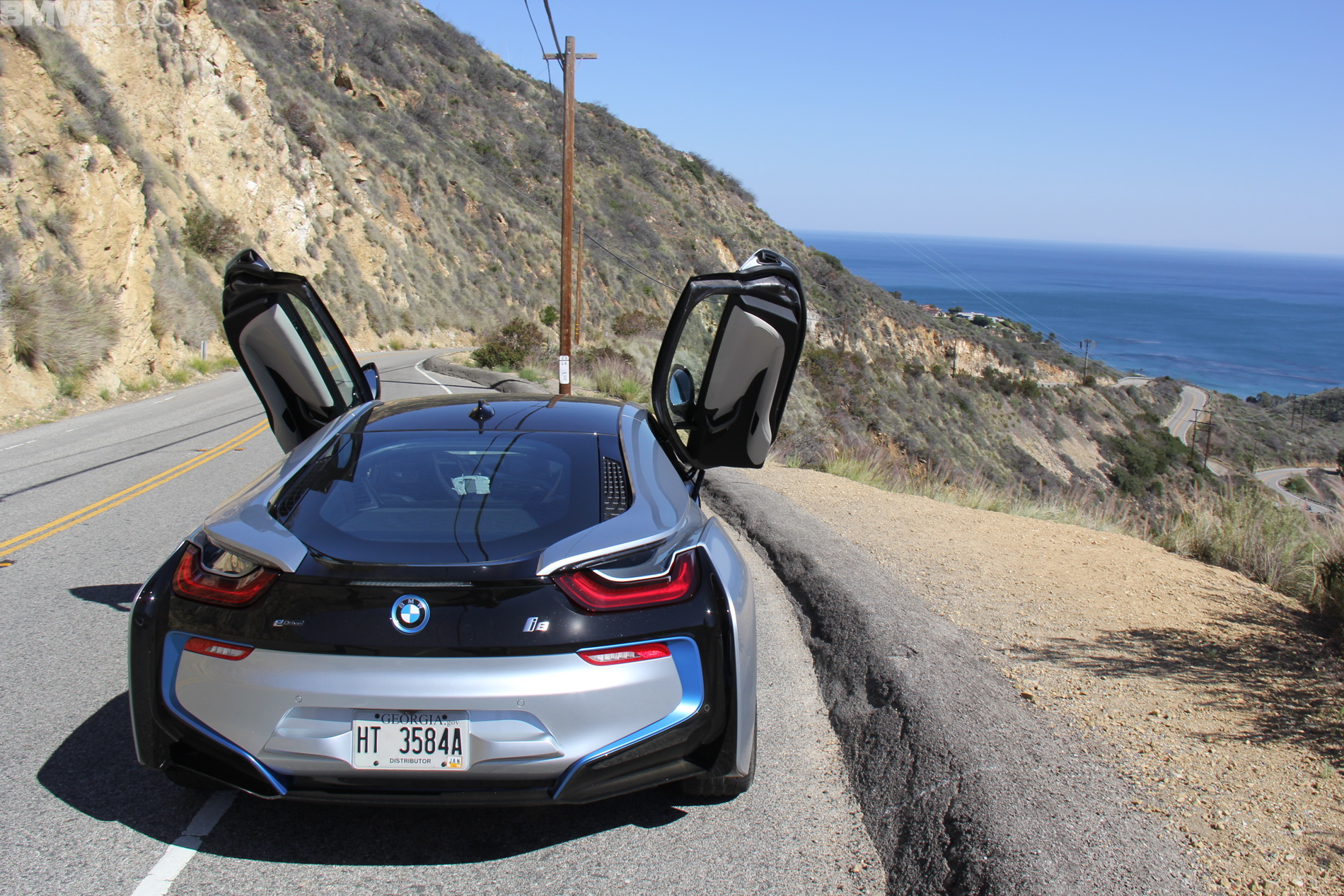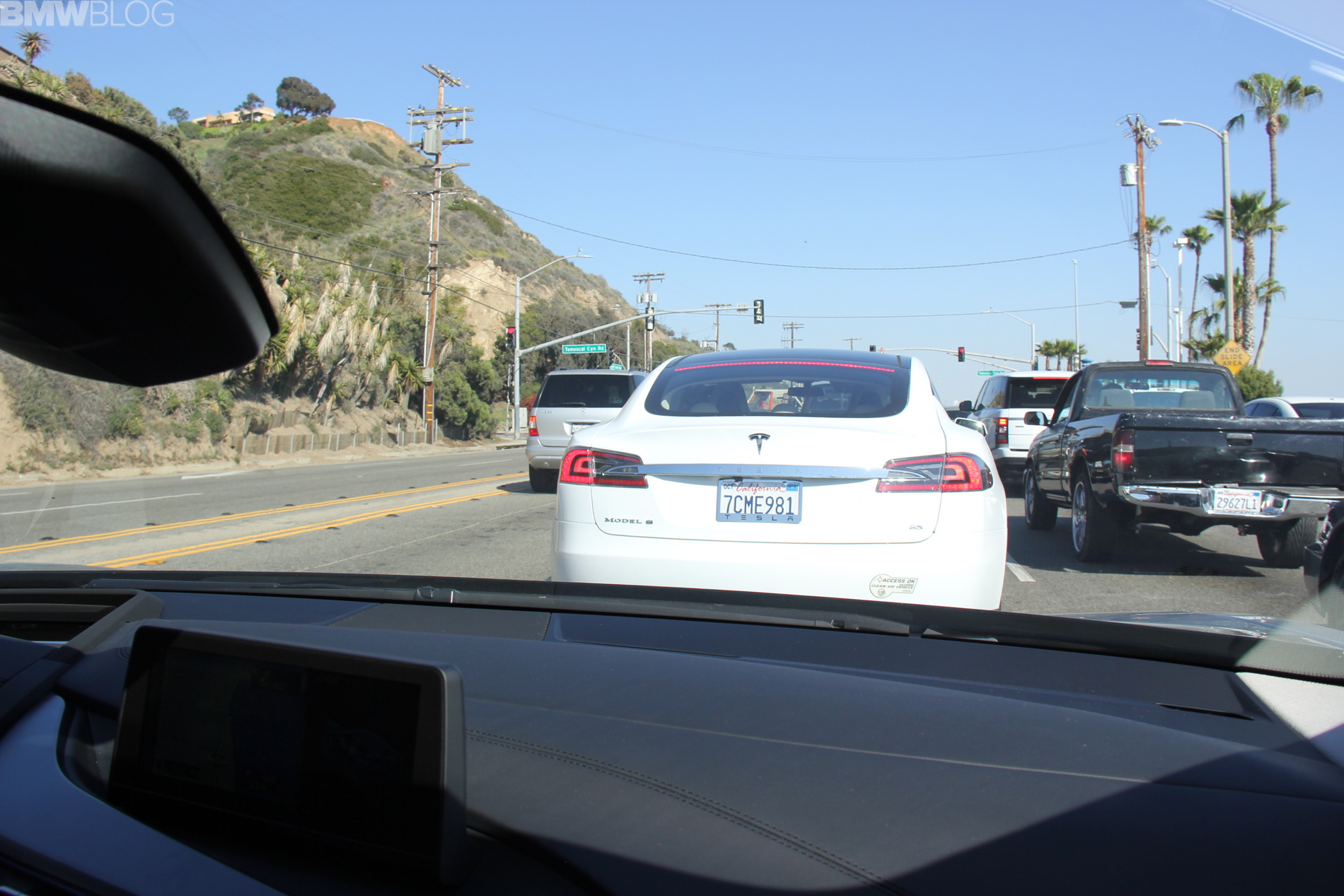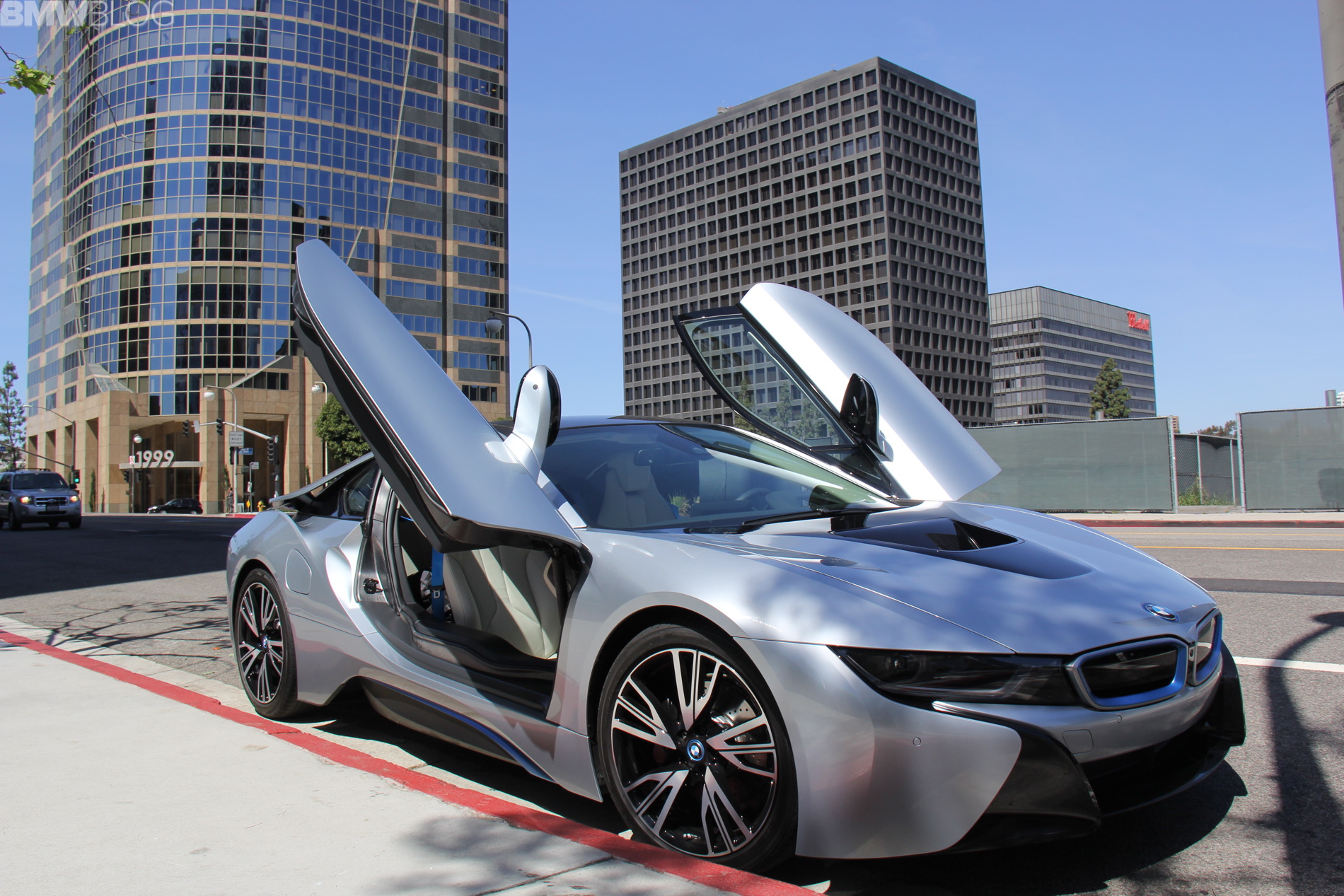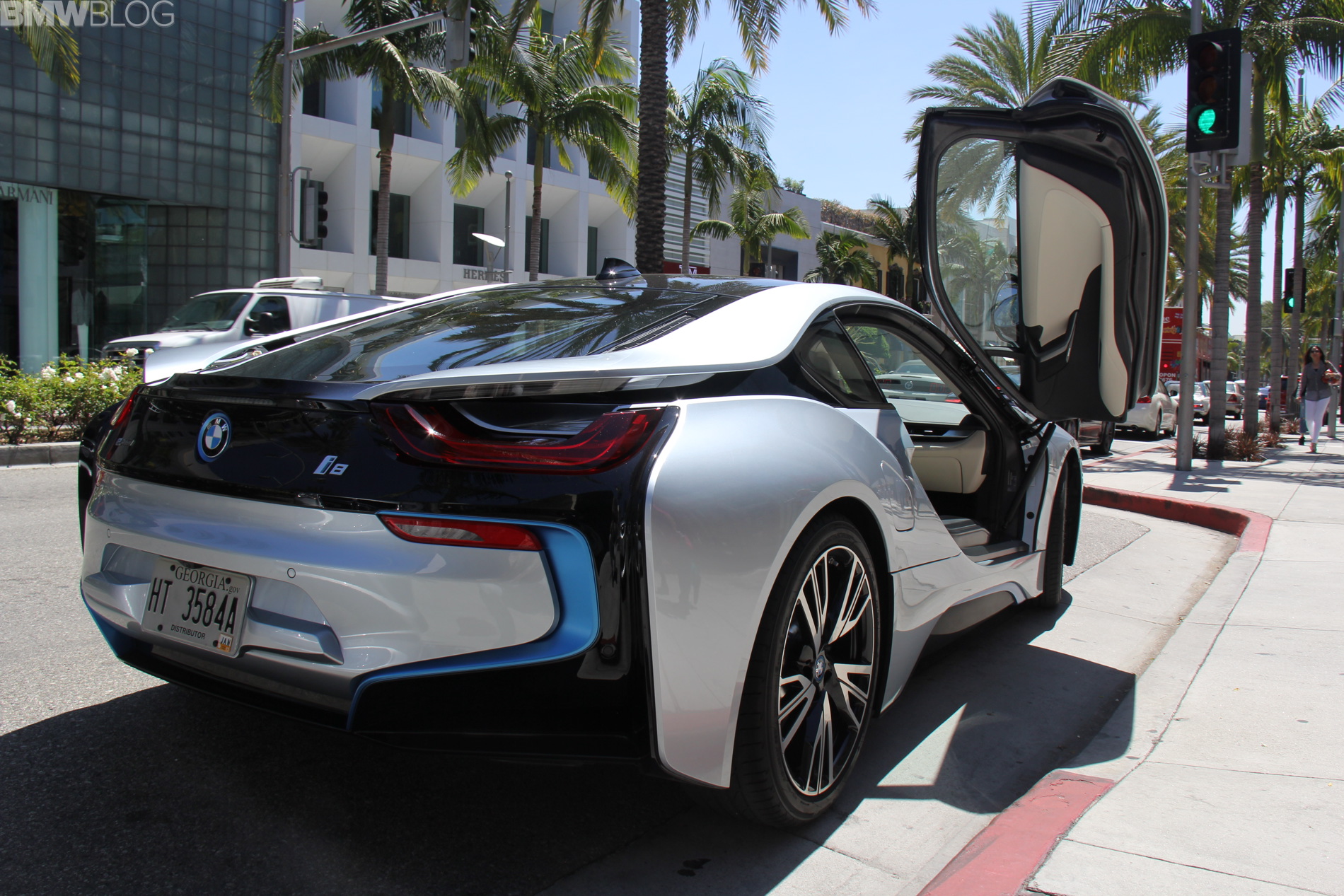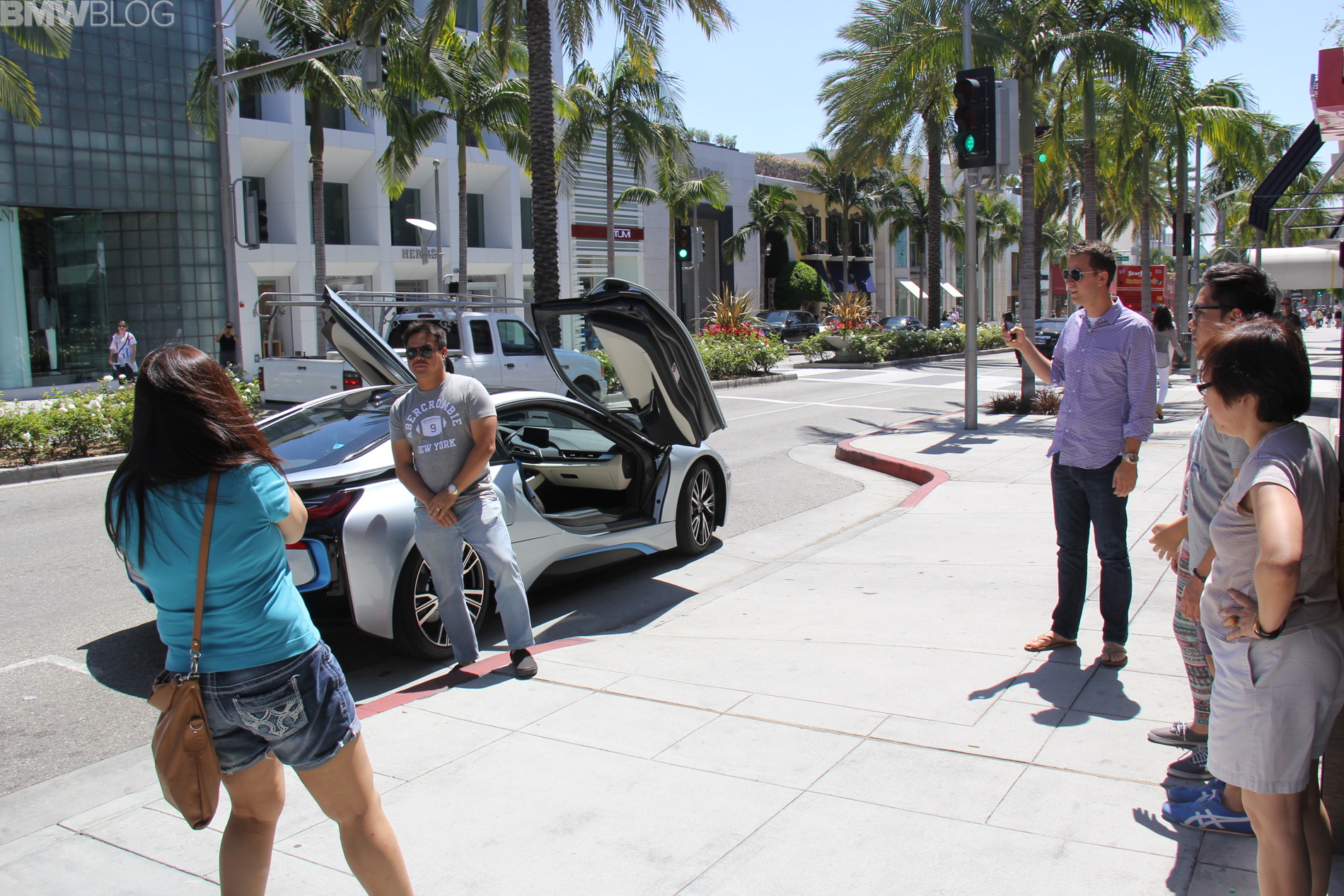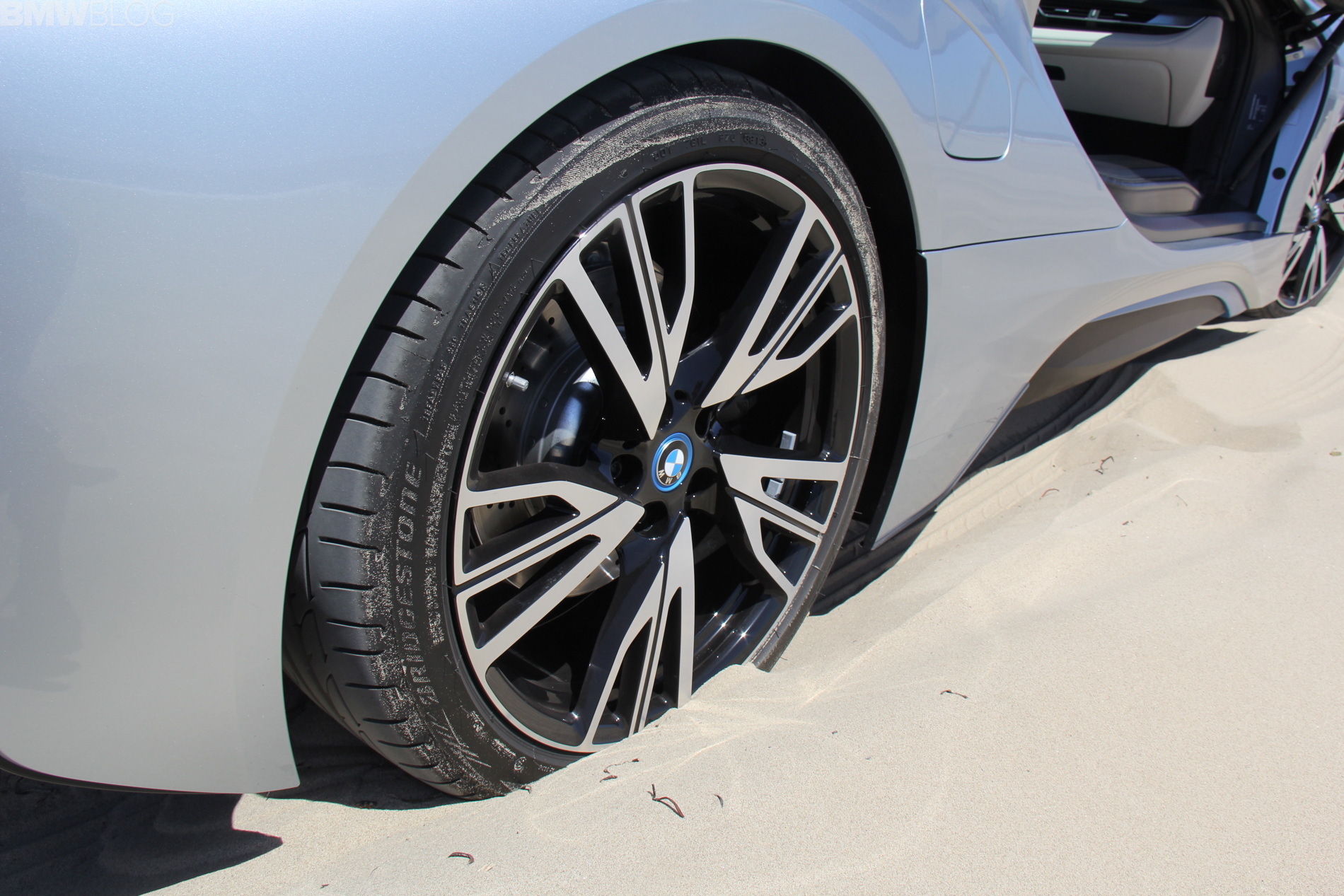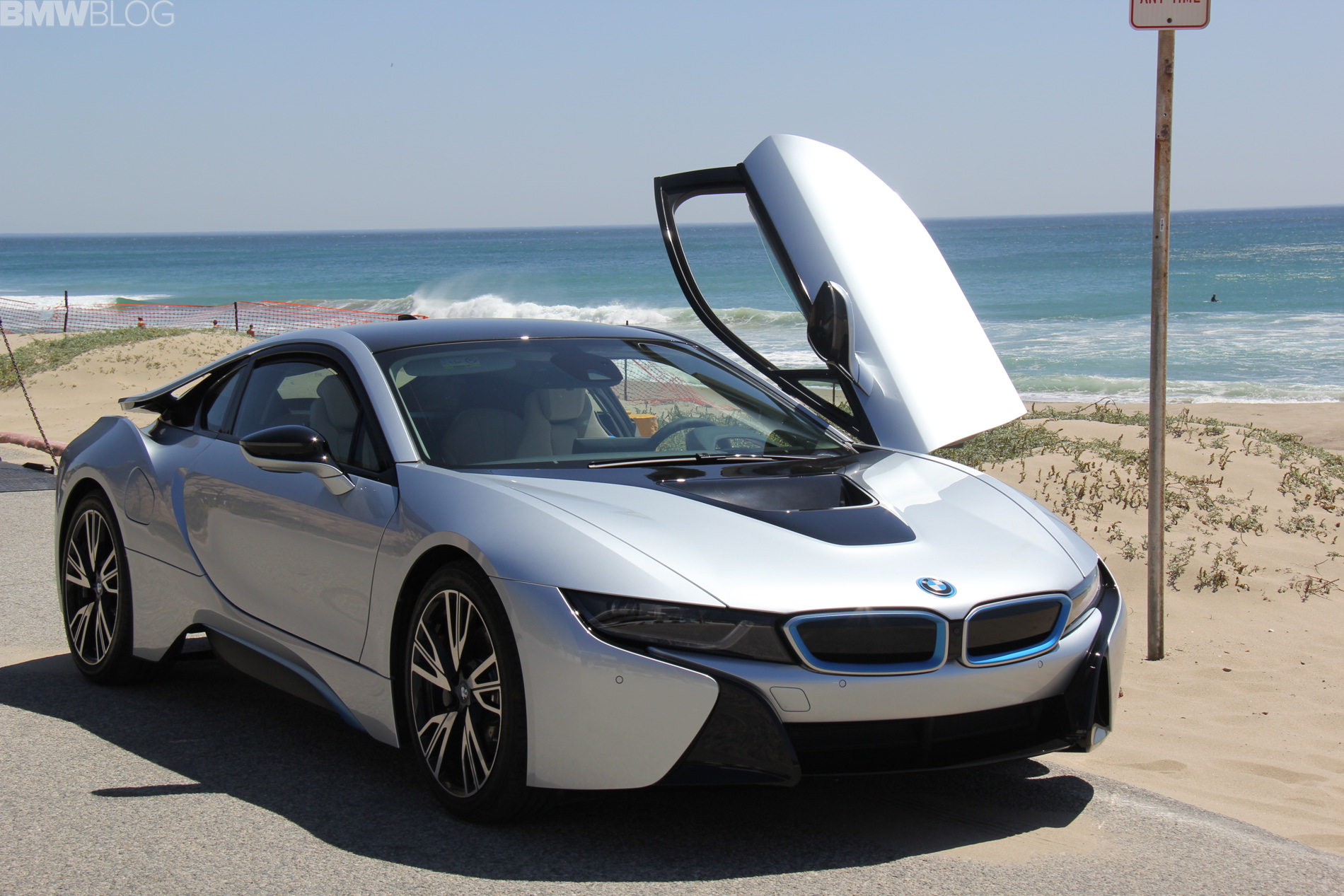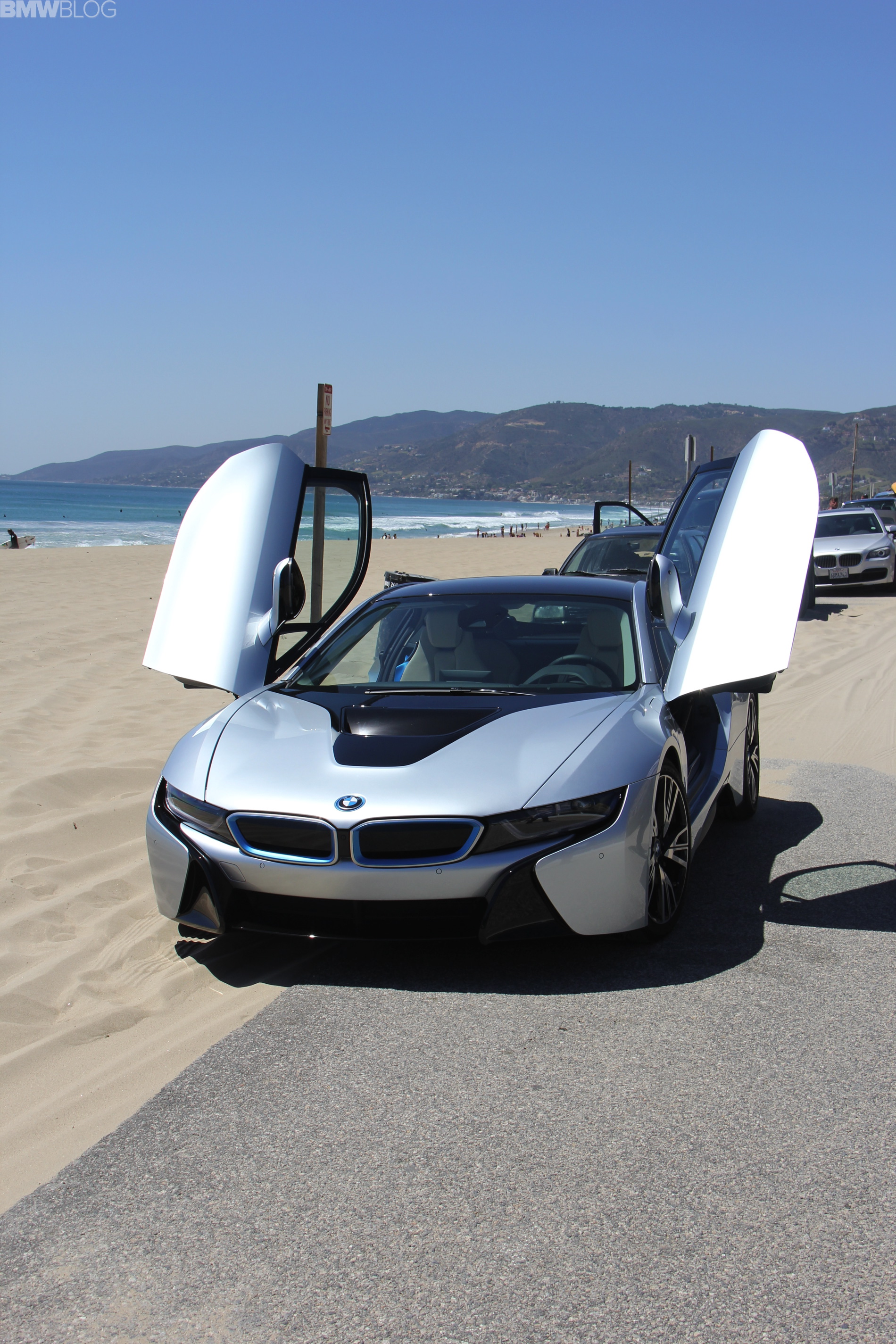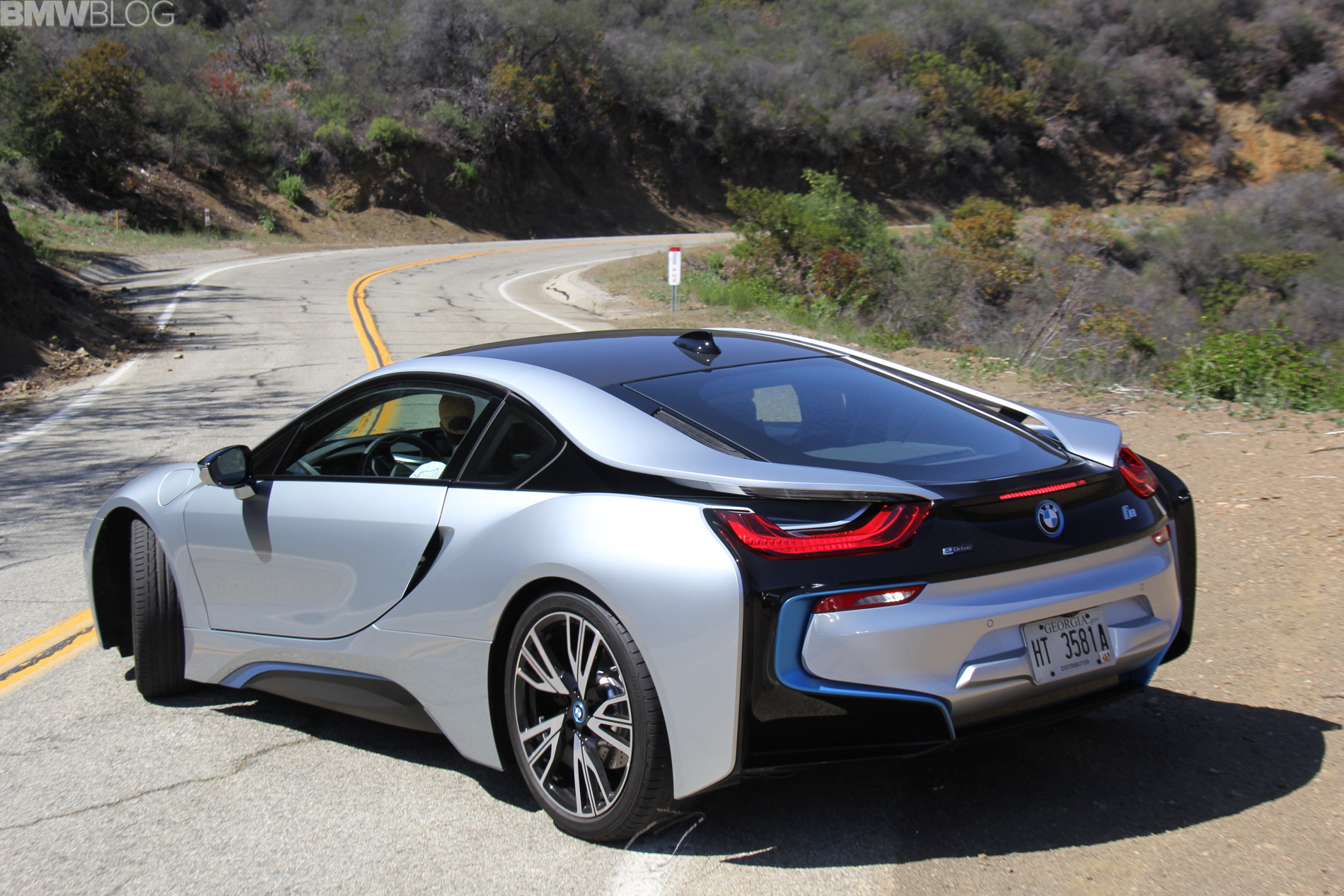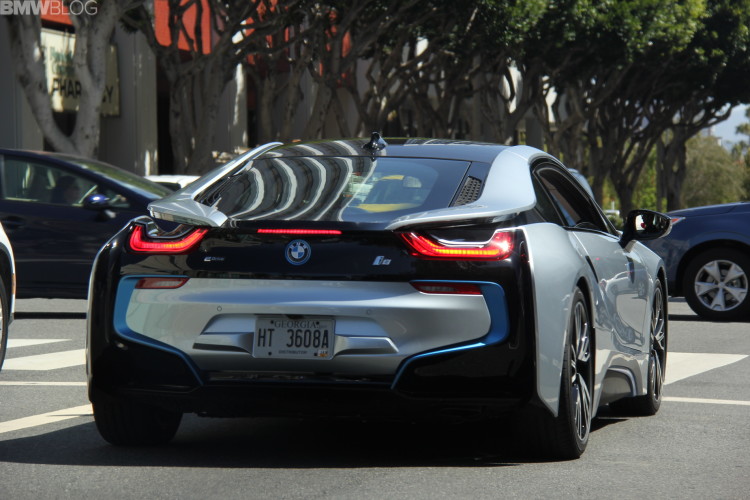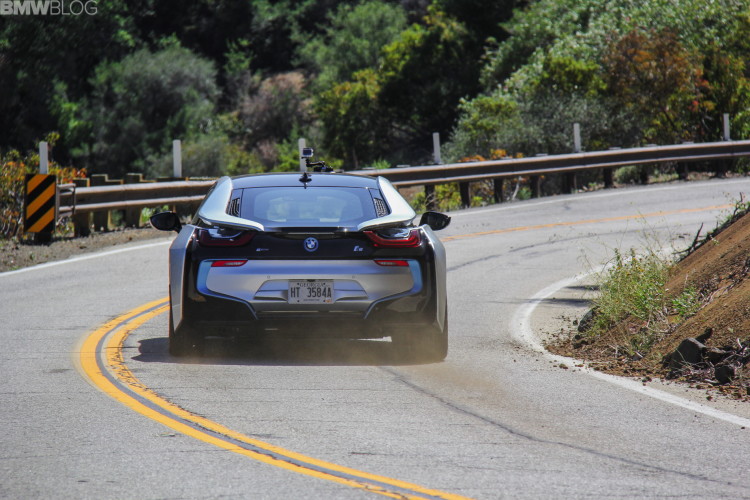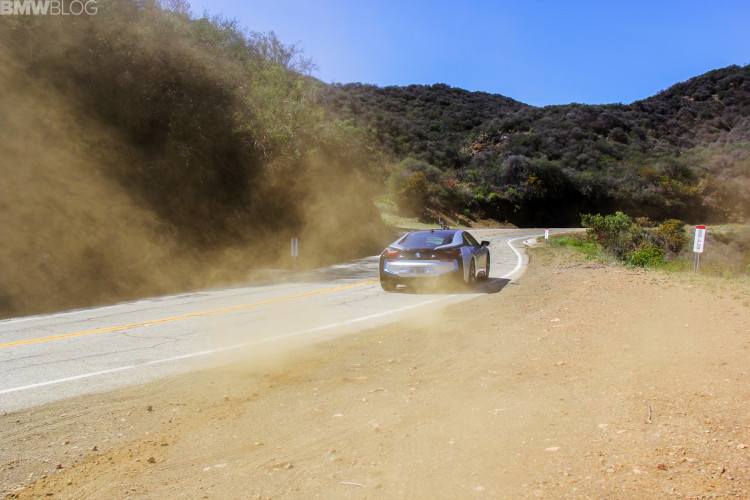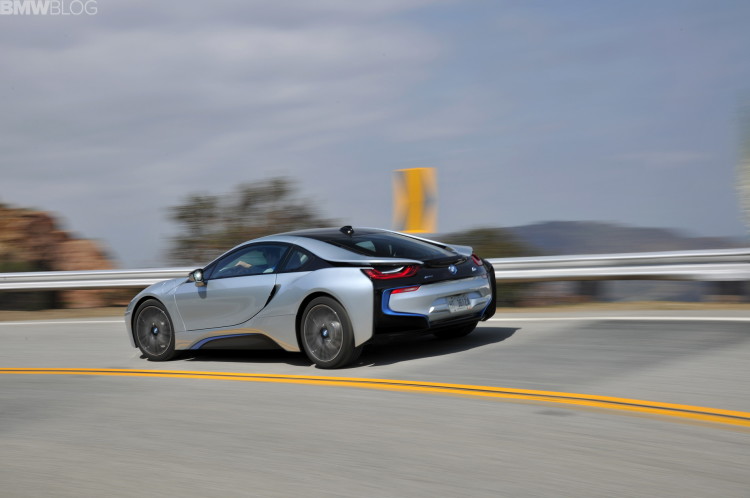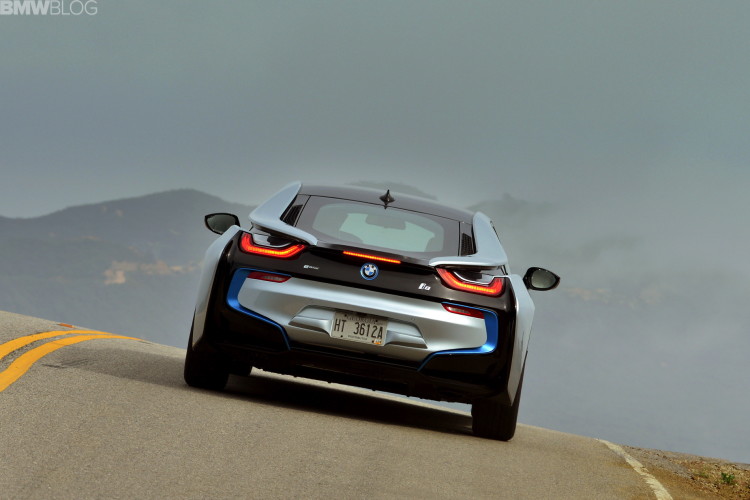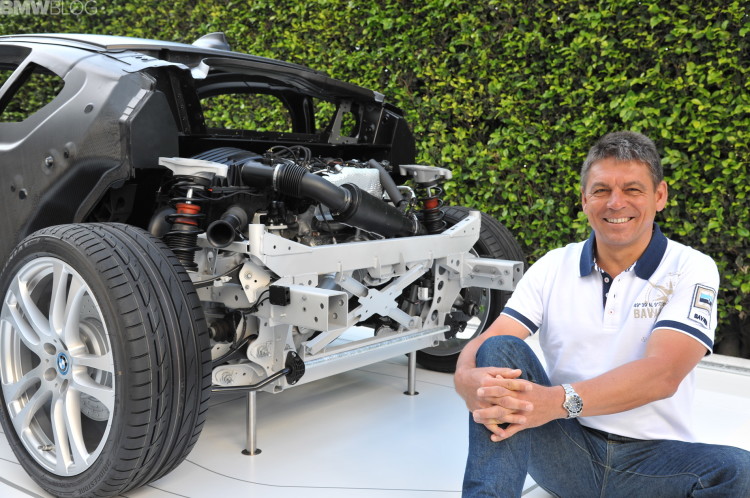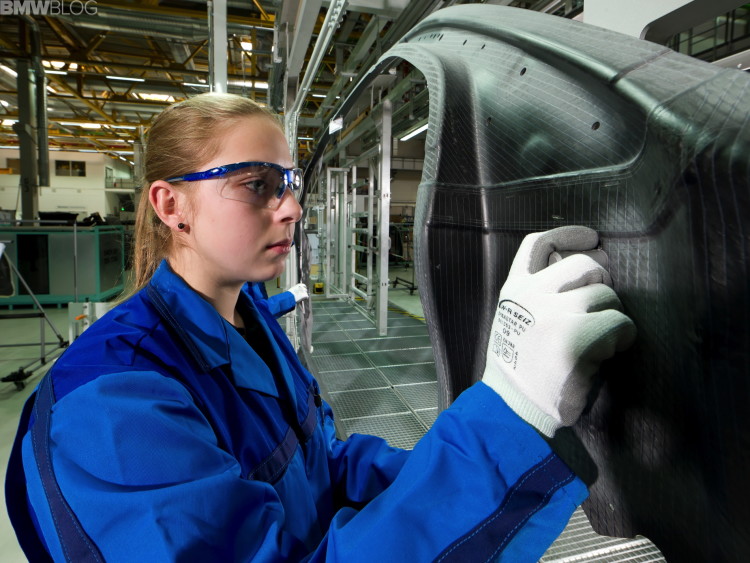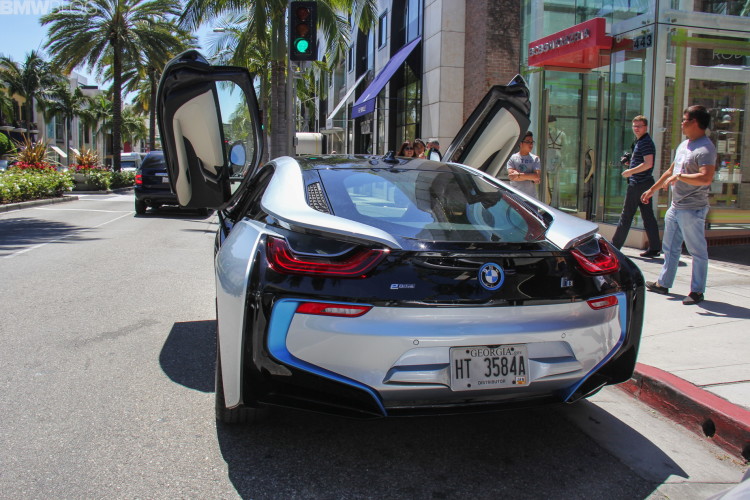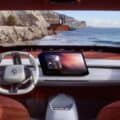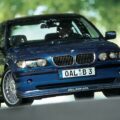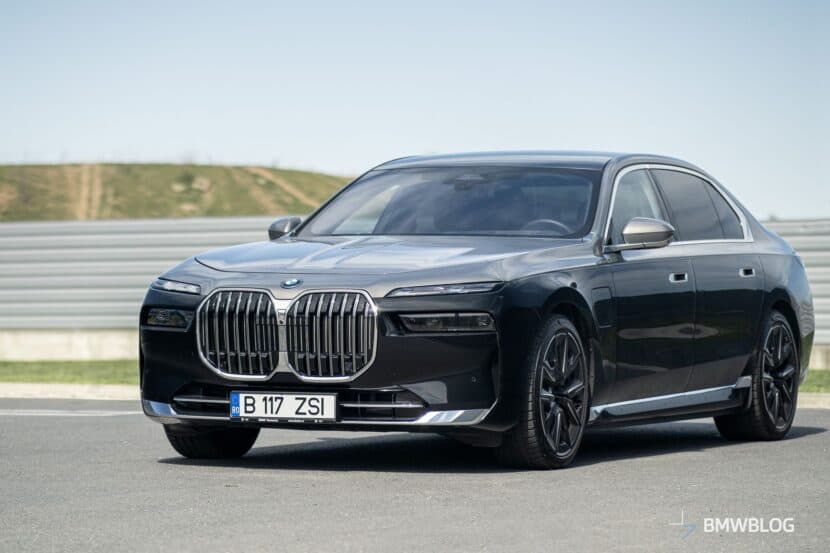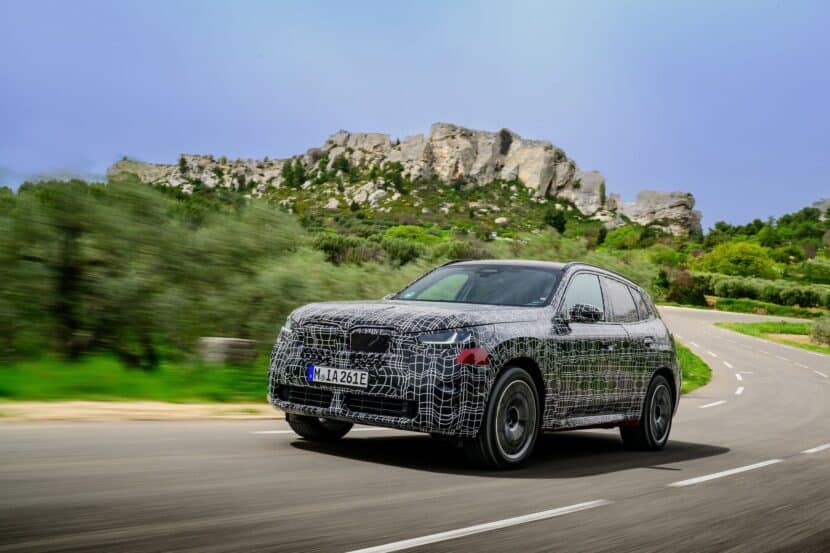Allow me from the beginning to express my feelings about this car: Oh my God this car is insanely good!
It has it all; exotic looks, high tech and performance figures to back it up. It is all priced well in relation to its alleged competitors. I know that BMW wants us to compare the i8 to the Porsche 911 4S, but I would venture to say its competition lies farther up the exotic food chain. The way people reacted when we parallel parked the BMW i8 on Rodeo Drive in Beverly Hills and pitched the doors up for photos, confirms that BMW has nailed the design. I’ve never gotten so many thumbs up while driving (and have been driving some cool cars in the past), people honking at us and non stop questions every time we stopped.
Heading to LA, I had three questions that needed to be answered about the i8.
First, why such a short range on the i8 pure electric mode? Second, does the i8 really compare to a Carrera 4S in the market? Third and more importantly, the i8 is pure automotive heaven but does it have the driving experience to match its killer looks?
DRIVING IMPRESSIONS
Going into the test drive, I knew that I would like to focus quite a bit on the driving experience since most of the i8 tech specs were fairly known.
We had the BMW i8 for one full day of driving around Los Angeles and Malibu in a variety of conditions from low speed inner city driving in pure electric mode to cruising Interstate 10 in Comfort Mode. The route included the famous Highway 1 along the California coastline. Pure electric mode requires the i8 to be set in either EcoPro or Comfort Mode. A special “pure electric” button is placed just below the Start/Stop. As long as the battery is sufficiently charged, it will engage. The gauges are blueish-green color and as you would imagine, the i8 is eerily quiet save a slight electric motor whine from the front.
I was rather happily surprised that even though the BMW i8 can run solely via electrically-powered front wheels, I felt zero torque steer. I was also rather impressed with how fast it scoots off the line in pure electric mode. I did find the brakes kind of grabby and hard to apply smoothly at first, at low speeds, but that’s in a way expected in a new car.
As a safety measure in pure electric mode, applying full throttle, called “kick down,” it fires up the 1.5 liter three-cylinder conventional engine to get you out of harms way. Just in case you just pulled out in front of a dump truck in full electroc mode. Eco Pro and Comfort can be run with or without pure electric mode engaged, or you can say to hell with it and just put it in Sport mode. In total, the BMW i8 has five driving modes. In pure electric modes, the 2015 BMW i8 can drive up to 23 miles in the EU test cycle and speeds up to 75 mph. Our pure electric range was shorter but that was because of my aggressive driving style.
Sport Mode is engaged by simply sliding the transmission lever into the Sport Mode position we all know from BMWs. This one swift movement of the gear lever and the whole character of the i8 changes. In Sport Mode, the engine will now run continuously and is more audible. The instrument cluster turns a dark orangish red. The i8 rips off sharper shifts and stiffens the electronic dampeners.
It wasn’t until after lunch that I realized just how good this car is. The i8 chassis has a front double wishbone and in the rear is a five-link rear axle. After lunch, we took the i8 up into the ever so curvy Mulholland Highway with its tight switch backs, narrow lanes and harrowing drop-offs. This portion of the drive was done in Sport Mode the whole time to have max power and sharpened chassis available.
I found that the handling was much more neutral than I anticipated. There is some understeer but not much. Given the sever punishment for going off the cliff, I didn’t really look to make the i8 oversteer ala Chris Harris style.
Under full throttle coming out of a tight bend, I never once felt the rear want to slide out. Powering out of bends, I could feel all four wheels grabbing the asphalt in a blast of acceleration. The two motors combine to give the driver very satisfying gobs of torque down low and turbo screamin’ up top. Road and Track just tested the i8 as 3.8 seconds for 0-60. The Dynamic Stability Control works really well and according to the BMW engineers, this is the same exact system that is used on all BMWs. When it was my turn to be in the passenger seat through the Canyon I could feel the DSC keeping the car in check when driver got a little over aggressive in the twisties.
The 2015 BMW i8 exhibited very very little body roll and has excellent handling. The only reason I disagree with some on how the i8 handles as compared to a Cayman is the way the i8 puts the power. Sometimes it can be a pure front wheel drive car. Other times, it can vary to a partial split, to finally a pure rear wheel drive. Each of those benefit from a different “racing line” and the driver cannot really control the split outside of pure electric mode being front wheel drive only. Further, I thought the shifting in Sport Mode was a little harsh. I didn’t drive the i8 like I would on a race track and realistically this is not going to be a track car. It was built to be an everyday sports car and at less than 9.5 tenth’s you wont notice.
For pure acceleration, nothing beats all-wheel drive, but when it comes to track style/performance, driving power on the front wheels can sometimes muddy the feed back in the steering. Only once did I sense the powertrain stumble and it was a crazy tight low speed turn in the Canyon. As I was rolling back on to the throttle, the i8 hesitated like wanted to use the front wheels to pull me out but then threw full power to the rear and it upset the handling for just a second. I do suspect, however, that will be addressed by the engineers through software programing.
Typically low rolling resistance narrow tires don’t lend themselves to big time grip. If you look at the outgoing E92M3 Competition Package, it has much larger tires 245/35/19 front and 265/35/19 rears. The 2015 BMW i8, in comparison, has rather narrow 195/50/20 front and 215/45/20 rear wheels, but has a longer contact patch thanks to the taller tires. BMW does offer larger 215/45/20 front and 245/40/20s as an option, and those were fitted to our test car. Brakes are 4-piston 340mm vented discs in the front and single piston 340mm vented discs in the rear. At low speeds, I found they were kind of grabby and take gentle application to smoothly stop the car. They were perfect though for the aggressive driving style in the canyons.
EXHAUST SOUND
One of the hardest things the BMW engineers had to do was find the proper balance on the sound of an i8. Should it sound like a wicked E92 M3 with BMW Performance Exhaust, or should it be silent as a Toyota Prius? BMW chose not one, but two answers to this difficult question. The answer lies in what mode you drive the BMW i8 in. While in EcoPro and Comfort the motor is not fully acoustically active. BMW didn’t want a loud performance engine firing up right behind your head if you are in a “green” driving mood.
If, however, you’re looking to drive a sports car, slide that transmission shifter over from drive to sport and the devil fires up the engine. Suddenly you can hear the motor much more and the whole instrument cluster turns orange/red hue to let you know the i8 means business. BMW said that it’s real engine sounds amplified in the cabin. Meaning the Active Sound we saw in the recent M models. This might make some upset but to me it fits with the mission of the car.
HYBRID POWER
The i8 has a crazy complex powertrain. A 131 hp electric motor that has 184 lb-ft of torque, powers the front wheels via a 2-speed transmission. Then add to the mix a mid-engine 1.5 liter three-cylinder turbo just inboard of the rear wheels which produces an astonishing 231 hp and is routed through a six-speed automatic transmission. Complex computing controls the balance of power such that the two motors compliment each other in every driving situation. This allows instantaneous torque from the electric motor to get you off the line and then the acceleration continues turbo lag free from the 1.5 liter motor.
The three-cylinder is literally half of the inline-six 3.0 liter engine. Pumping out 231 hp at 5800 rpm along with 236 lb-ft, this three-cylinder nuclear power plant has the highest specific output at 154 hp per litre of any production BMW motor. The electric motor is indeed the same as in the i3 but has a different horsepower rating and a 2-speed transmission in the i8. The i8 handles battery with cooling via refrigerant and the battery has a 7.1 kWh capacity that is warrantied for 8 years or 62,000 miles in Europe.
Though the i8 has five different drive/chassis settings, the main difference is in Sport and everything else. In everything else you can choose to go full electric until the battery runs low and the engine will kick on. Interestingly the motor is rather quiet in these non-Sport modes. Thomas Weinhammer, Head of Functional Integration for the i8, said they didn’t want to upset the harmony of the car. When you max performance out of the i8 you put in Sport Mode and the engine instantaneously fires up with very pronounced burble. Weinhammer said if you were in pure electric mode and the engine needed to come on, they wanted to accomplish this with out a huge engine rasp firing up behind you and making you spill your Starbucks. You know us Americans LOVE our Starbucks.
I asked Weinhammer to help explain the 2-speed transmission on the electric motor. I wondered if it would shift a certain speed. Surprisingly, the lower gear is for pure electric driving mode only. If you are in any other mode, the electric motor is in second gear. He said they didn’t want it to be shifting of the electric motor to upset the balance of the car.
CHASSIS AND BATTERY
BMWBLOG asked Carsten Breitfeld, Head of BMW i8 Vehicle Project, why such a seemingly short range on the pure electric mode and he said the answer lies in weight of the batteries. BMW’s goal was to make the most efficient sports car they could but keep the overall weight less than 1500 kg (about 3300 lbs). BMW felt like if they went up on the battery capacity, the additional weight would adversely effect the handling and performance of the car. BMW placed the batteries in the center tunnel of the car where they are the most protected from crashes. Furthermore, he said the i8 pure electric mode should be enough to cover most owner commuting.
The weight of the BMW i8 is kept low via an aluminum “Drive Module” that is responsible for propulsion and which houses important crash structural protection as well as the motors. The passenger area is referred to as the “Life Module” which is made of the Carbon-Fiber-Reinforced Plastic passenger cell and outer plastic body panels. BMW took weight savings so seriously that they use magnesium support structure for the instrument panel as well as foam plastic A/C ducts that weigh 60% less than their traditional counter parts. Gorilla glass, the same as found in your iPhone, is lightweight and durability is used between the engine and passenger cab, saving 50% weight over traditional glass. It was not used elsewhere in the car because it cannot be made into curved structures.
ENVIRONMENTAL IMPACT
BMW’s attention to the environmental impact of the car is truly remarkable. From extensive use of CFRP (Carbon Fiber Reinforced Plastic) made by hydroelectric, to a BMW manufacturing plant powered by 100% renewable electricity. BMW even uses olive leaf extract to dye the leather. Even the casing for the i8’s key is made from a castor bean biopolymer.
DESIGN
Design wise the 2015 BMW i8 is ground breaking for BMW and its i sub-division. Low slung at just 51 inches tall and 76.5 inches wide, the i8 has traffic stopping gullwing doors. The i8 has a flowing black ribbon color from front to back. Floating C-pillars formed with “stream flow” contour of the air path are sweeping over the side where the airflow dictated the design and helps the i8 achieve a drag coefficient of 0.26.
The interior design envelopes the driver with well placed gauges, BMW’s class leading Head-Up Display and an 8.8” iDrive Control Display. The iDrive display can be configured to show live where the power is coming from when you drive. The i8 has a fully digital instrument cluster display that is simply stunning. Flip the car into Sport Mode and the hybrid sportscar turns the gauges from blue/green to orange red. The center airvent is angled towards the driver and to make up for this, BMW placed two of them on the passenger’s side. There are two small vestigal seats in the back that held my backpack full of camera and video equipment, and will work in a pinch for adults but only for short distances. Seats provide plenty of back support and are comfortable even though they are thinner than typical BMW seats.
DOES THE BMW i8 LIVE UP TO THE HYPE?
At dinner after a long day of driving, one of the engineers stumped me with a simple question. “What do you not like about the car?” It took about ten minutes for me to formulate a decent answer outside of wishing for a longer pure electric range. BMW i8 looks every bit like an exotic car, as judged by the overwhelming swarm of people that mobbed us when we stopped to get some pics with the doors open. It however, does not have that supercar performance numbers. The last nit pick I had about the i8 is that the A and C-pillars are fairly large and they can occasionally obstruct the view. Thankfully there is a really good back up camera we put to good use when we parallel parked the i8 twice on Rodeo Drive. I also wished it had bigger sticker rubber on it, but understand that it has low rolling resistance tires for better fuel economy.
What is the useful range of i8? A lot really depends on how you drive it. As far as gas mpg goes, if you can commute to work and back in full electric mode, you can get up to 23 miles without a drop of gas. In Europe the fuel tank is 42 liter or 11.1 gallons. The actual EPA figures are not out, and BMW confirmed the same fuel tank size for the U.S. market. The ranges still vary from 310 miles to 375 miles depending on where you look.
Furthermore, the laser lights equipped i8 models we got demo rides in are not yet approved for the U.S. market and may require some changes to meet regulations.
As to the answer to my three opening questions, here they are. First, the electric range issue. BMW’s goal for the i8 was to be under 1500kg to provide sports car handling with a the range that takes care of most city commutes. Second, the BMW i8 can technically compare to the Porsche 911 4S in that both have all four wheels driven and a 2+2 configuration. However, the i8 has the caché of a super car. No 911 4S would have gotten the reception our i8 did on Rodeo Drive. Third, the i8 provides an insanely good driving experience and in my opinion it does match the killer looks.
The future of automobiles is here and it doesn’t suck, it’s awesome!
Reviewed by Review by Chuck Vossler on
.
The future of automobiles is here and it doesn’t suck, it’s awesome!
The BMW i8 can technically compare to the Porsche 911 4S in that both have all four wheels driven and a 2+2 configuration.
Rating: 4.8




